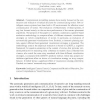Free Online Productivity Tools
i2Speak
i2Symbol
i2OCR
iTex2Img
iWeb2Print
iWeb2Shot
i2Type
iPdf2Split
iPdf2Merge
i2Bopomofo
i2Arabic
i2Style
i2Image
i2PDF
iLatex2Rtf
Sci2ools
126
Voted
ICIDS
2009
Springer
2009
Springer
Comparing Effects of Different Cinematic Visualization Strategies on Viewer Comprehension
Abstract. Computational storytelling systems have mainly focused on the construction and evaluation of textual discourse for communicating stories. Few intelligent camera systems have been built in 3D environments for effective visual communication of stories. The evaluation of effectiveness of these systems, if any, has focused mainly on the run-time performance of the camera placement algorithms. The purpose of this paper is to present a systematic cognitive-based evaluation methodology to compare effects of different cinematic visualization strategies on viewer comprehension of stories. In particular, an evaluation of automatically generated visualizations from Darshak, a cinematic planning system, against different hand-generated visualization strategies is presented. The methodology used in the empirical evaluation is based on QUEST, a cognitive framework for question-answering in the context of stories, that provides validated predictors for measuring story coherence in readers. ...
| Added | 25 Jul 2010 |
| Updated | 25 Jul 2010 |
| Type | Conference |
| Year | 2009 |
| Where | ICIDS |
| Authors | Arnav Jhala, R. Michael Young |
Comments (0)

